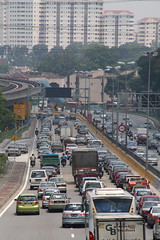
So Ops Sikap ended yesterday and major newspapers covered the increase in road accidents and related deaths. Almost every interview that covered this topic has some politician or public figure commenting on society’s attitude towards road safety being the primary reason for our blood smeared roads.
In a recent interview broadcasted on TV3, Malaysia’s IGP; Tan Sri Musa Hassan, had even remarked that even if traffic offences are punishable by death, Malaysians would still drive dangerously and with disregard to other road users.
Whether this is true or not, I doubt we’ll ever find out. I’m sure that there are just too many bad drivers in Parliament that will shoot down the dossier to shreds in a heartbeat.
However, I can’t understand why those who gather these Ops Sikap stats are only obsessed with getting the number of accidents, deaths, vehicle type and location. This data merely covers the facts directly related to the accidents.
I’ve yet to see these reports coupled with important supplimentary data like the number of road tax renewals for the past 18 months, or sales figures of road vehicles for the past year.
Why do we need these supplementary data? Because it will paint a more precise picture of our accident stats. How? Because with these supplementary stats, we’ll have a fairly accurate ratio of accidents to the number of licensed vehicles on the road.
Personally, I’m not surprised at all looking at the increasing number of accidents and deaths reported at the end of each Ops Sikap. I find it perfectly normal as I’m absolutely certain that the number of vehicles on Malaysian roads have increased in similar percentages over that time period.
What I’m concerned more about is the attitude of not only Malaysian society in general, but specifically the traffic law enforcement entities like the JPJ and traffic police.
For one thing, they know that during the festive seasons, accidents will definitely be on the rise due to the elevated number of vehicles on the road. So what should they do?
For the past seven years, the police have concentrated their efforts on issuing traffic summonses. Quite a significant number of these summonses are “saman ekor” (literal translation: tail summonses; ie. summonses issued through the use of photographic evidence and sent to the registered vehicle’s owner through post).
This approach begs the question; Is this a proactive or reactive response to the root problem? I’d say it’s the latter because the offence has already been committed!
And how painful is the Malaysian traffic summons anyway?
On average, the fine for traffic offences in Malaysia is in the region of RM150-RM300 (speeding or not stopping at red lights).
Similar offences in Singapore will set you back by S$1000 (for first offender), a jail sentence of 6 months or both! So how much is S$1000 in RM? Roughly RM2450!
A proactive approach to tackling this problem would be by increasing road blocks and highway patrols. From my recent trip to KL on Hari Raya (September 20th, 2009) and the subsequent return trip back to JB two days later; I encountered no(zero, zilch, kosong, absolutely none!) such checks on both trips!
And this is for a combined 650km trip up and down the North-South Highway (PLUS)!
This makes me wonder whether Ops Sikap is just an exercise where the traffic authorities perform their regular “pot calling the kettle black” routine; Just blame the drivers… we’ve done all we can!
Or perhaps I’m the one who forgets that the traffic police and JPJ need to have their festivities holidays too… and the work they perform subsequently grinds to a halt as well.
